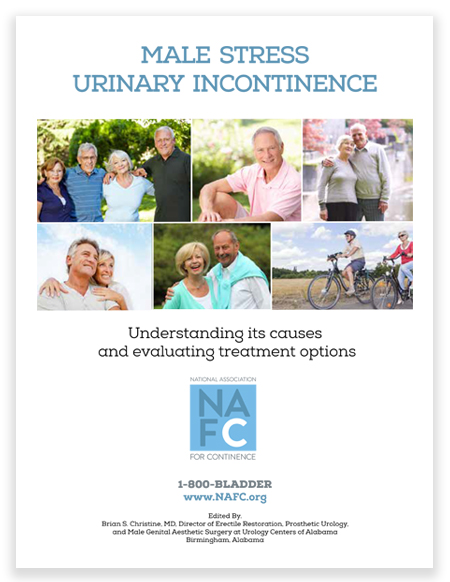Stress Incontinence in Men
JOIN OUR NEWSLETTER
Receive custom tools to help you manage your condition and get the latest in bladder and bowel health from NAFC!
MALE STRESS URINARY INCONTINENCE
Before we get into the details on Stress Urinary Incontinence (SUI) a quick review of the male plumbing system is in order. As you may recall from biology class, the kidneys main job is to filter out waste from the blood. Once it does so, it mixes this waste with water and sends it to the bladder. The bladder holds the urine until it’s time to pee. While the bladder muscle squeezes, the sphincter (yes, you have more than one) relaxes, allowing the urine to be released. Any sort of physical stress on the system can cause urine to be released unintentionally. That’s SUI.
CAUSES
In men, the biggest cause of SUI results from a procedure to remove a benign or a cancerous prostate that has enlarged, resulting in difficulties urinating. Most medical minds agree that this manifests in one of two ways. Either damage to the urinary sphincter leads to incontinence or the removal of physical support creates functional problems for the sphincter when the prostate gland is removed. This is known as post-prostatectomy incontinence.
When the strength of the sphincter muscle is compromised, urine may leak through the urethra. Under pressure to the bladder, such as with a golf swing or a sneeze, leakage may be slight. However, depending on the severity of damage, the impaired sphincter could allow a steady stream of urine, enough to soak your underwear.

Click here to download your free brochure on stress urinary incontinence in men, including information about its causes and treatment options.
TREATMENT OPTIONS
To pinpoint the culprit in your SUI, your physician can perform diagnostic tests to evaluate function and exact cause of the leakage. Along with a physical exam and medical history, other tools such as a urine flow test, blood tests, cystoscopy, and urodynamic testing may be used to develop a clearer picture. It may also be helpful to keep a diary to document your urinary habits. Once diagnosed, there are several treatment options available.
While loss of bladder control after prostate surgery may be a devastating complication which can have a significant, negative impact on quality of life, men should feel encouraged by the increasing number of treatment and management options available to them. With appropriate evaluation and treatment, problems with SUI are usually treatable so that dignity and quality of life can be restored. Regardless of the treatment option selected, men should continue pelvic muscle exercises to optimize the degree of continence attained as well as for sexual performance and vitality.
MANAGEMENT
With the increased attention on incontinence issues, incredible progress and innovation have been made in the arena of products for everyday use.
Click here to read more about male products for stress urinary incontinence.
BEHAVIORAL MODIFICATIONS
-
Fluid management. With supervision from your physician, reducing amount of dietary irritants (coffee, colas, etc.) as well as limiting fluid intake while maintaining 6-8 8oz. glasses of water a day may help to reduce symptoms.
NON-INVASIVE TREATMENT
SURGICAL TREATMENT
-
Male Sling. A mesh implant that compresses the urethra and moves it, allowing for better function.
-
Artificial Urinary Sphincter. An inflatable cuff that allows the man to control the flow of urine, releasing the cuff when time to urinate, then inflating to keep leakage from occurring.
PHARMACEUTICAL TREATMENT
Want to LEARN MORE? Check out OuR Webinar!
Hear from Dr. Herman Bagga, MD FACS about Male Stress Urinary Incontinence. In this webinar Dr. Bagga outlines signs and symptoms, causes and discusses the full range of treatment options.
Developed in partnership with NAFC & Boston Scientific.
RELATED ARTICLES

How to be an effective caregiver for your loved one – and for yourself
Caregiving for someone with incontinence can be challenging, demanding and frustrating at times – but it can also be an expression of love and an opportunity to strengthen a bond with someone you care deeply about. Today’s guest is Michelle Mongillo from First Quality, who recently authored Caring with Dignity: A Caregiver’s Guide to Incontinence.
It’s a fantastic resource to help those looking after a patient with bladder or bowel issues, but it’s also a remarkable introduction for those dealing with these conditions themselves.

Learn About Black Friday Deals On Incontinence Products
We all know that absorbent products aren’t cheap. The average person with incontinence spends well over $100 per month on products to combat bladder leaks.

Ask The Expert: Do You Have Any Tips For Helping My Elderly Parents With Clothing & Absorbents Changes?
Q: My elderly parent(s) experience incontinence, and for the first time, I am being asked to help with their clothing and absorbent product changes. I feel like I’m in over my head. Do you have any tips or suggestions?
A: When it comes to helping your aging loved ones with managing incontinence changes and cleanups, the conversations around these intimate activities can be awkward for both sides. It can even change the dynamics of your relationship. Here are a few tips to make it easier on you and on them.



